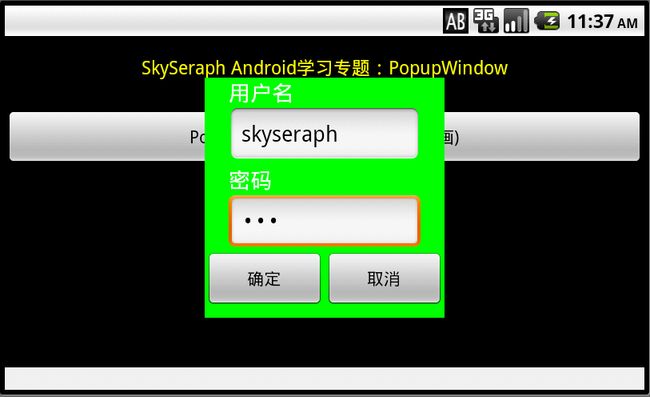PopupWindow
1 PopupWindow & Dialog:
PopupWindow是一个阻塞式的弹出框(在我们退出这个弹出框之前,程序会一直等待),Dialog非阻塞式弹出框(后台还可以做其他事情)
2 PopupWindow使用步骤总结
Ⅰ 自定义PopupWindow布局文件,并获取获取其实例
Ⅱ 创建PopupWindow对象,定义相关属性
Ⅲ PopupWindow界面显示
Ⅳ 响应自定义布局的事件
布局文件(主):popupwindow_demo.xml
<?xml version="1.0" encoding="utf-8"?>
<LinearLayout xmlns:android="http://schemas.android.com/apk/res/android"
android:layout_width="fill_parent"
android:layout_height="wrap_content"
android:orientation="vertical" >
<TextView
android:layout_width="fill_parent"
android:layout_height="wrap_content"
android:gravity="center_horizontal"
android:paddingBottom="25dp"
android:paddingTop="15dp"
android:text="SkySeraph Android学习专题:PopupWindow"
android:textColor="#FFFF00"
android:textSize="15dp"
android:id="@+id/popupwindow_demo_TV">
</TextView>
<LinearLayout
android:layout_width="fill_parent"
android:layout_height="wrap_content"
android:orientation="vertical"
android:layout_gravity="center">
<Button
android:id="@+id/popupwindow_demo_btn01"
android:layout_width="fill_parent"
android:layout_height="wrap_content"
android:text="PopupWindow弹出对话框演示(动画)" >
</Button>
</LinearLayout>
</LinearLayout>
布局文件(自定义):popupwindow_demo01.xml
<?xml version="1.0" encoding="utf-8"?>
<LinearLayout xmlns:android="http://schemas.android.com/apk/res/android"
android:layout_width="fill_parent"
android:layout_height="wrap_content"
android:background="#000000"
android:orientation="vertical" >
<TextView
android:id="@+id/popupwindow_demo01_TVUsername"
android:layout_width="fill_parent"
android:layout_height="wrap_content"
android:layout_marginLeft="20dip"
android:layout_marginRight="20dip"
android:text="用户名"
android:textAppearance="?android:attr/textAppearanceMedium" />
<EditText
android:id="@+id/popupwindow_demo01_ETUername"
android:layout_width="fill_parent"
android:layout_height="wrap_content"
android:layout_marginLeft="20dip"
android:layout_marginRight="20dip"
android:capitalize="none"
android:textAppearance="?android:attr/textAppearanceMedium" />
<TextView
android:id="@+id/popupwindow_demo01_TVPassword"
android:layout_width="fill_parent"
android:layout_height="wrap_content"
android:layout_marginLeft="20dip"
android:layout_marginRight="20dip"
android:text="密码"
android:textAppearance="?android:attr/textAppearanceMedium" />
<EditText
android:id="@+id/popupwindow_demo01_ETPassword"
android:layout_width="fill_parent"
android:layout_height="wrap_content"
android:layout_marginLeft="20dip"
android:layout_marginRight="20dip"
android:capitalize="none"
android:password="true"
android:textAppearance="?android:attr/textAppearanceMedium"
android:inputType="numberSigned"/>
<LinearLayout
android:layout_width="fill_parent"
android:layout_height="wrap_content"
android:gravity="center" >
<Button
android:id="@+id/popupwindow_demo01_BtnOK"
android:layout_width="wrap_content"
android:layout_height="wrap_content"
android:layout_weight="60"
android:text="确定" >
</Button>
<Button
android:id="@+id/popupwindow_demo01_BtnCancel"
android:layout_width="wrap_content"
android:layout_height="wrap_content"
android:layout_weight="60"
android:text="取消" >
</Button>
</LinearLayout>
</LinearLayout>
java代码:popupwindow_demo.java
public class popupwindow_demo extends Activity
{
// //////////////////////////////////////////////////////////////////////////////
@Override
protected void onCreate(Bundle savedInstanceState)
{
// TODO Auto-generated method stub
super.onCreate(savedInstanceState);
setContentView(R.layout.popupwindow_demo);
findViews();
}
// //////////////////////////////////////////////////////////////////////////////
private void findViews()
{
Button btn1 = (Button) findViewById(R.id.popupwindow_demo_btn01);
btn1.setOnClickListener(new OnClickListener()
{
public void onClick(View v)
{
// TODO Auto-generated method stub
showPopupWindow1(popupwindow_demo.this,
popupwindow_demo.this.findViewById(R.id.popupwindow_demo_btn01));
return;
}
});
}
// //////////////////////////////////////////////////////////////////////////////
// //////////////////////////////////////////////////////////////////////////////
private void showPopupWindow1(Context context, View parent)
{
///////////////////////////////////////////////////////
// 【Ⅰ】 获取自定义popupWindow布局文件
//方式一:
//LayoutInflater inflater = (LayoutInflater) context.getSystemService(Context.LAYOUT_INFLATER_SERVICE);
//final View vPopupWindow = inflater.inflate(R.layout.popupwindow_demo01, null, false);
//方式二:
final View vPopupWindow = getLayoutInflater().inflate(R.layout.popupwindow_demo01,
null,false); // 加载popupWindow的布局文件
vPopupWindow.setBackgroundColor(Color.GREEN); // 设置popupWindow的背景颜色
///////////////////////////////////////////////////////
// 【Ⅱ】 创建PopupWindow实例
final PopupWindow pw = new PopupWindow(vPopupWindow, 300, 300, true);// 声明一个弹出框 ,最后一个参数和setFocusable对应
pw.setContentView(vPopupWindow); // 为弹出框设定自定义的布局
//pw.setBackgroundDrawable(getResources().getDrawable(R.drawable.rounded_corners_pop));//设置整个popupwindow的样式。
pw.setAnimationStyle(R.style.AnimationPreview); // 设置动画效果
pw.setFocusable(true); //默认为false,如果不设置为true,PopupWindow里面是获取不到焦点的,那么如果PopupWindow里面有输入框等的话就无法输入。
// /////////////////////////////////////////////////////
// 【Ⅲ】 显示popupWindow对话框
// 获取屏幕和对话框各自高宽
int screenWidth, screenHeight, dialgoWidth, dialgoheight;
screenWidth = popupwindow_demo.this.getWindowManager().getDefaultDisplay().getWidth();
screenHeight = popupwindow_demo.this.getWindowManager().getDefaultDisplay().getHeight();
dialgoWidth = pw.getWidth();
dialgoheight = pw.getHeight();
// pw.showAsDropDown(parent); //以自己为Anchor,不偏移
// pw.showAsDropDown(parent, (screenWidth-dialgoWidth)/2, 0);//以自己为Anchor,偏移(screenWidth-dialgoWidth)/2, 0)--按钮正下方
pw.showAtLocation(parent, Gravity.CENTER, 0, 0);// 以屏幕中心为参照,不偏移
// pw.showAtLocation(parent, Gravity.BOTTOM, 0, 0);//以屏幕左下角为参照
/* 注释:
* 【showAsDropDown & showAtLocation】
* showAsDropDown(View anchor)相对某个控件的位置(正左下方),无偏移
* showAsDropDown(View anchor, int xoff, intyoff) 相对某个控件的位置,有偏移(正数表示下方右边,负数表示(上方左边))
* showAtLocation(View parent,int gravity, int x, int y) gravity依靠父布局的位置如Gravity.CENTER x y 坐标值
*/
///////////////////////////////////////////////////////
// 【Ⅳ】自定义布局中的事件响应
// OK按钮及其处理事件
Button btnOK = (Button) vPopupWindow.findViewById(R.id.popupwindow_demo01_BtnOK);
btnOK.setOnClickListener(new OnClickListener()
{
@Override
public void onClick(View v)
{
TextView textView = (TextView)findViewById(R.id.popupwindow_demo_TV);
EditText edtUsername = (EditText) vPopupWindow.findViewById(R.id.popupwindow_demo01_ETUername);
edtUsername.setHint("请输入您的用户名!");
edtUsername.setInputType(InputType.TYPE_TEXT_FLAG_AUTO_CORRECT);
edtUsername.setInputType(InputType.TYPE_NULL); //不显示软键盘
EditText edtPassword = (EditText) vPopupWindow.findViewById(R.id.popupwindow_demo01_ETPassword);
edtPassword.setHint("请输入您的密码!");
textView.setText("你输入的用户名是:" + edtUsername.getText().toString() + "\n"
+"你输入的密码是:"+edtPassword.getText().toString());
pw.dismiss();// 关闭
}
});
// Cancel按钮及其处理事件
Button btnCancel = (Button) vPopupWindow.findViewById(R.id.popupwindow_demo01_BtnCancel);
btnCancel.setOnClickListener(new OnClickListener()
{
@Override
public void onClick(View v)
{
pw.dismiss();// 关闭
}
});
}
}
<?xml version="1.0" encoding="utf-8"?>
<resources xmlns:android="http://schemas.android.com/apk/res/android">
<!-- popupwindow_demo 中动画文件 -->
<style name="AnimationPreview">
<item name="android:windowEnterAnimation">@anim/fade_in</item>
<item name="android:windowExitAnimation">@anim/fade_out</item>
</style>
</resources>
fade_in.xml
<set xmlns:android="http://schemas.android.com/apk/res/android" >
<scale
android:duration="700"
android:fillAfter="false"
android:fromXScale="0.0"
android:fromYScale="0.0"
android:interpolator="@android:anim/accelerate_decelerate_interpolator"
android:pivotX="50%"
android:pivotY="50%"
android:toXScale="1.0"
android:toYScale="1.0" />
</set>
fade_out.xml
<set xmlns:android="http://schemas.android.com/apk/res/android" >
<scale
android:duration="700"
android:fillAfter="false"
android:fromXScale="1.0"
android:fromYScale="1.0"
android:interpolator="@android:anim/accelerate_decelerate_interpolator"
android:pivotX="50%"
android:pivotY="50%"
android:toXScale="0.0"
android:toYScale="0.0" />
</set>


